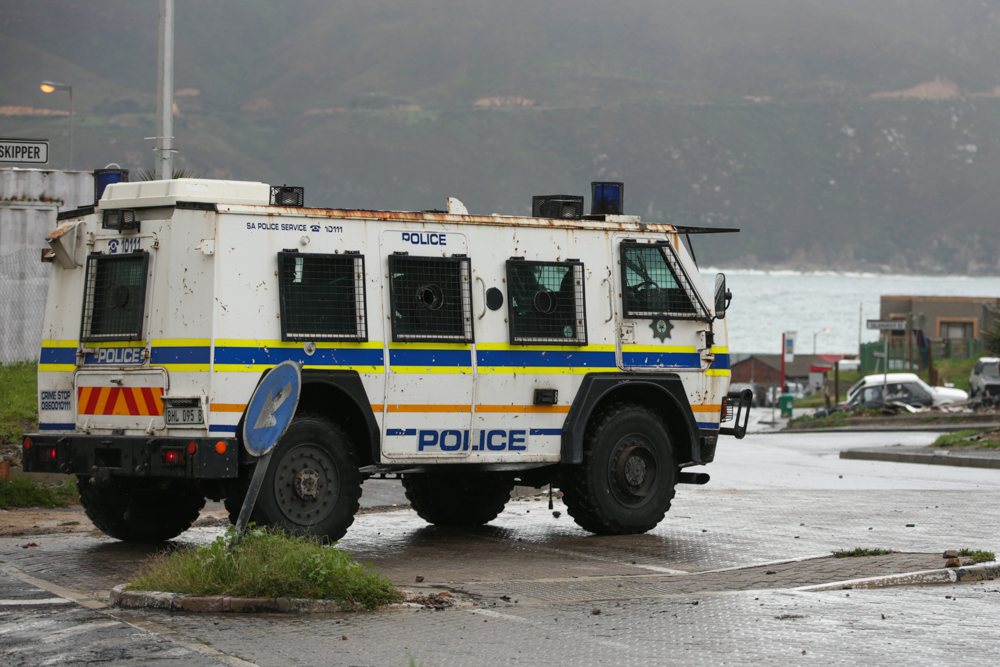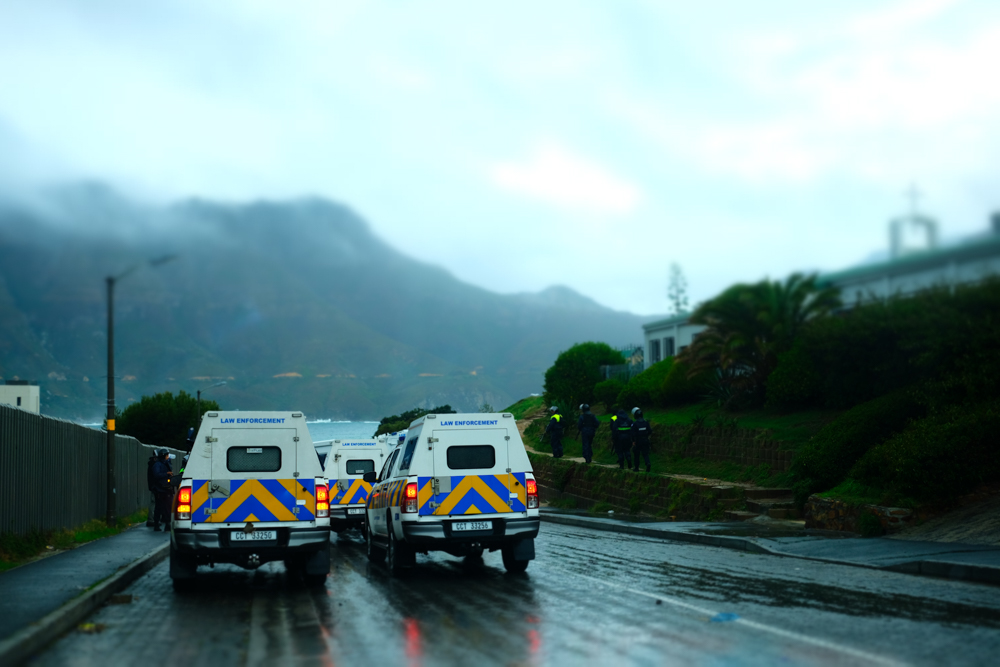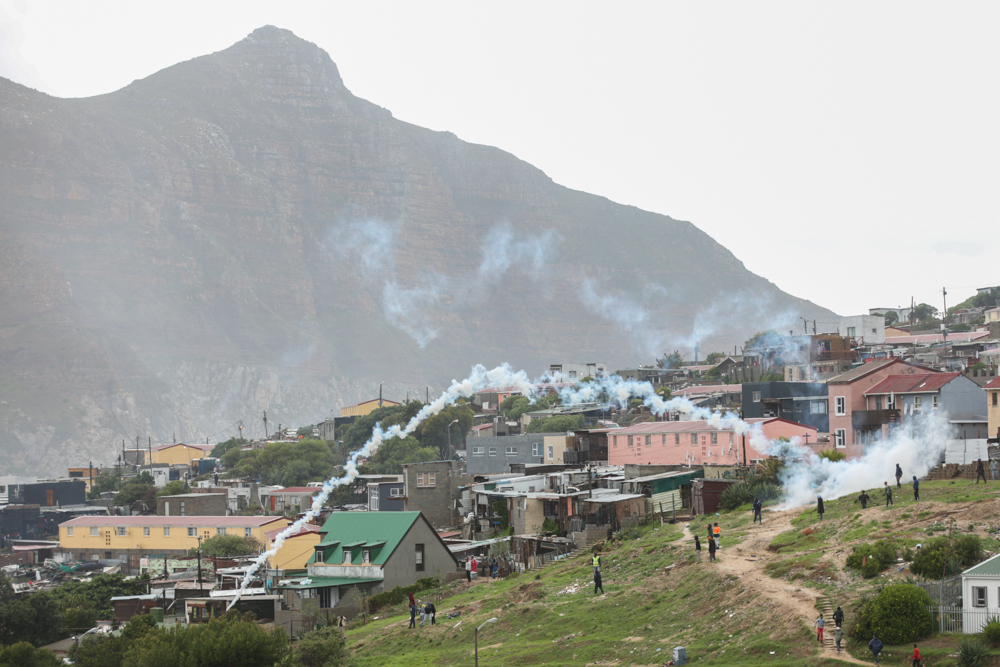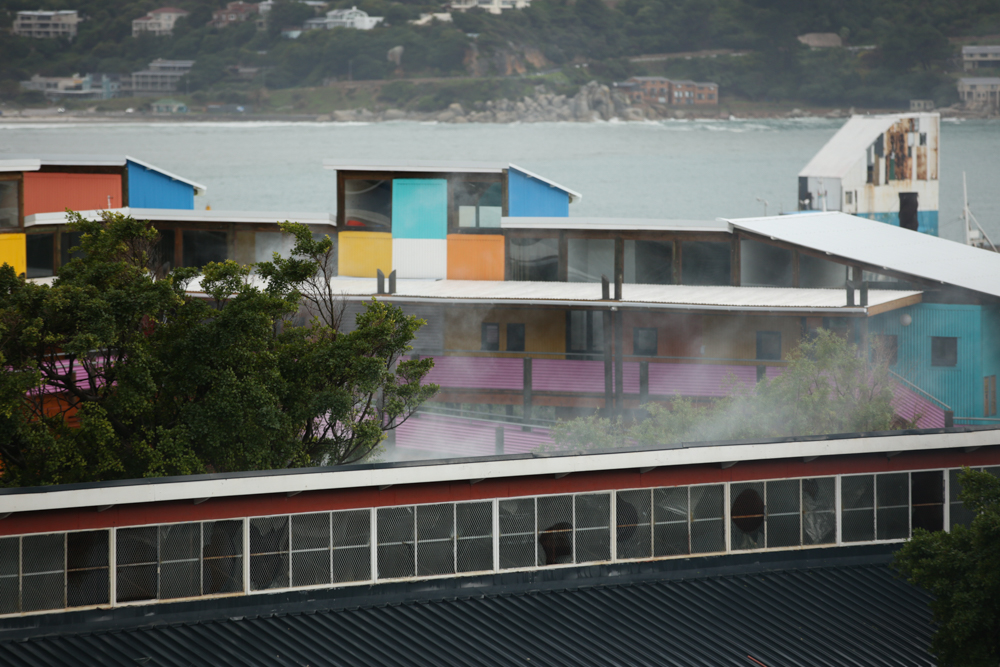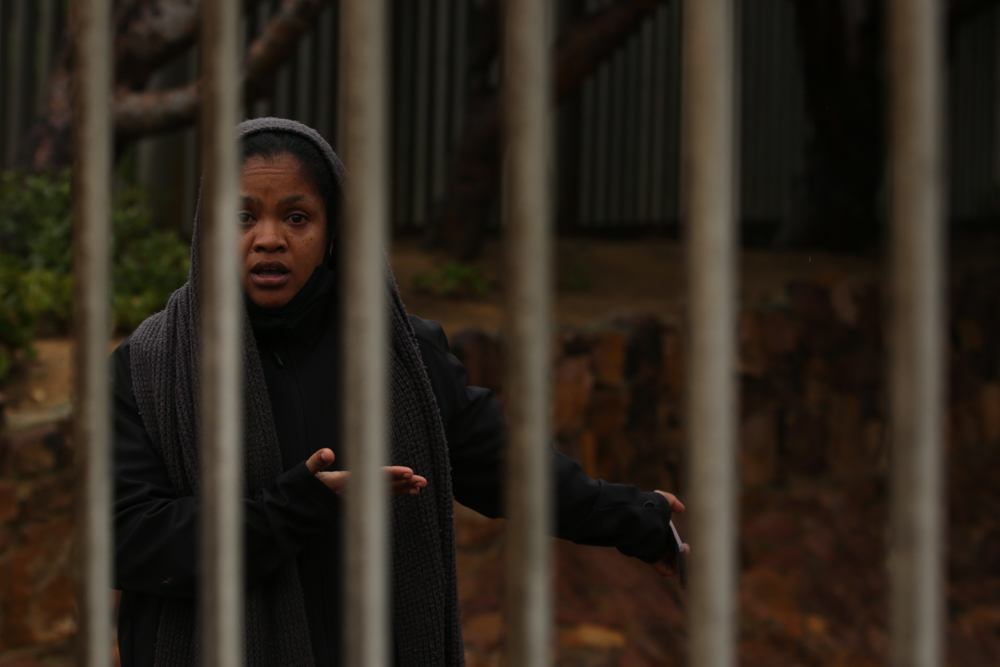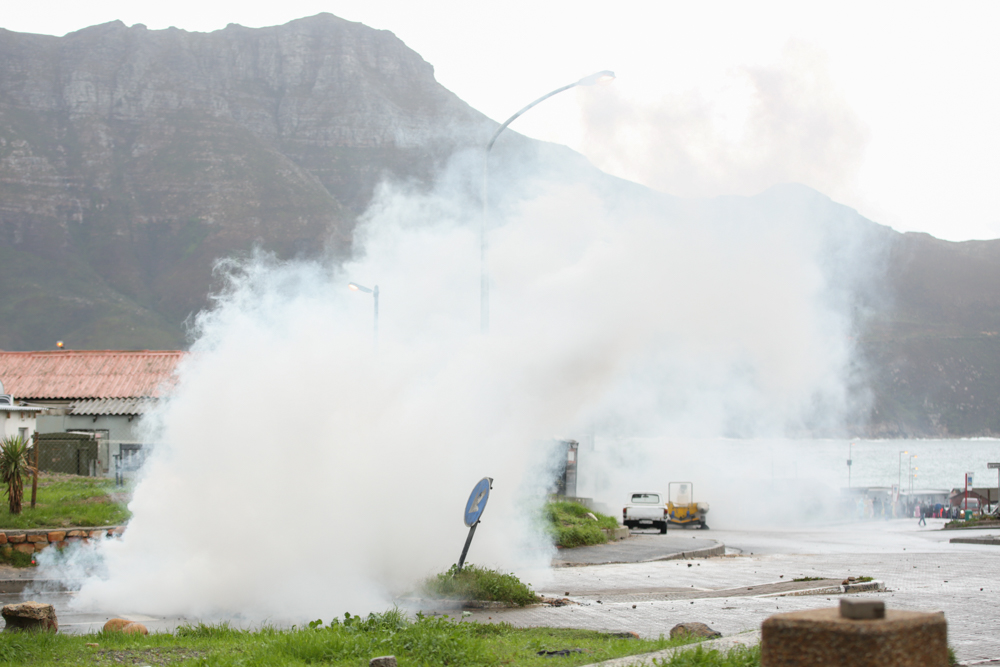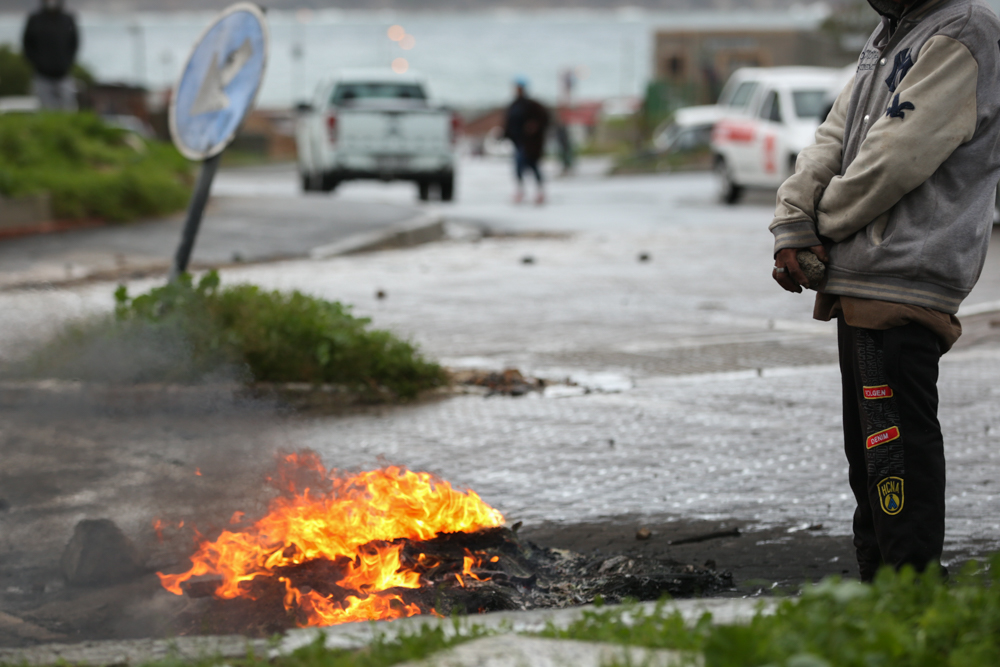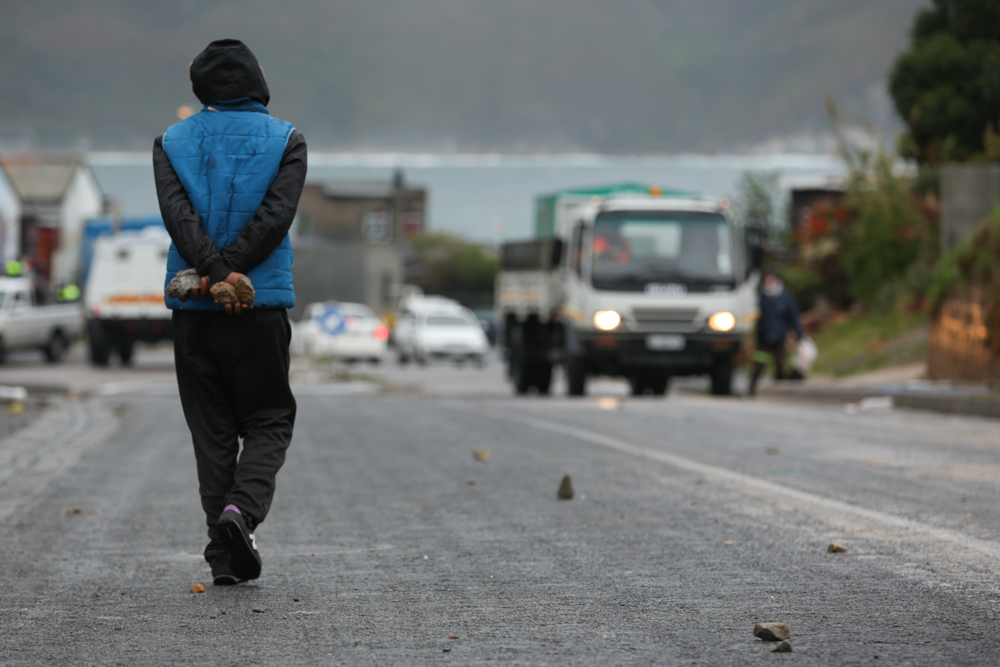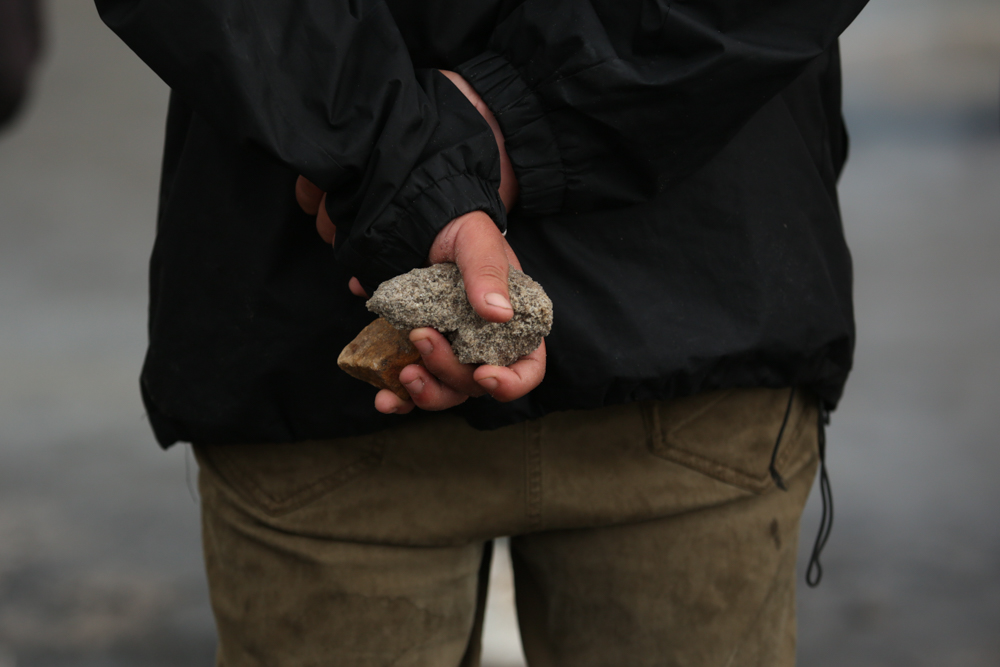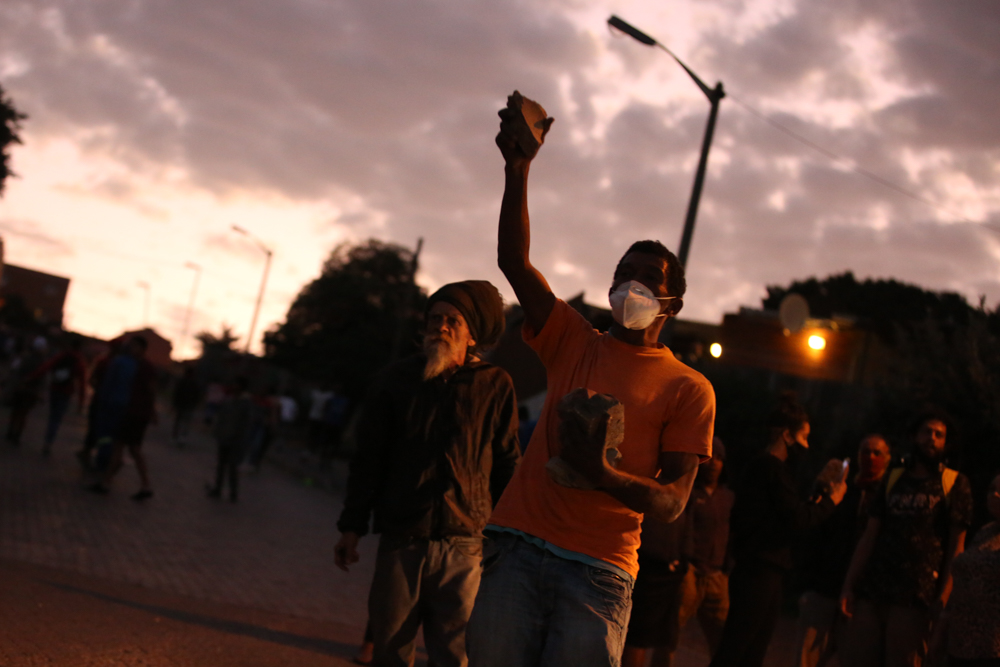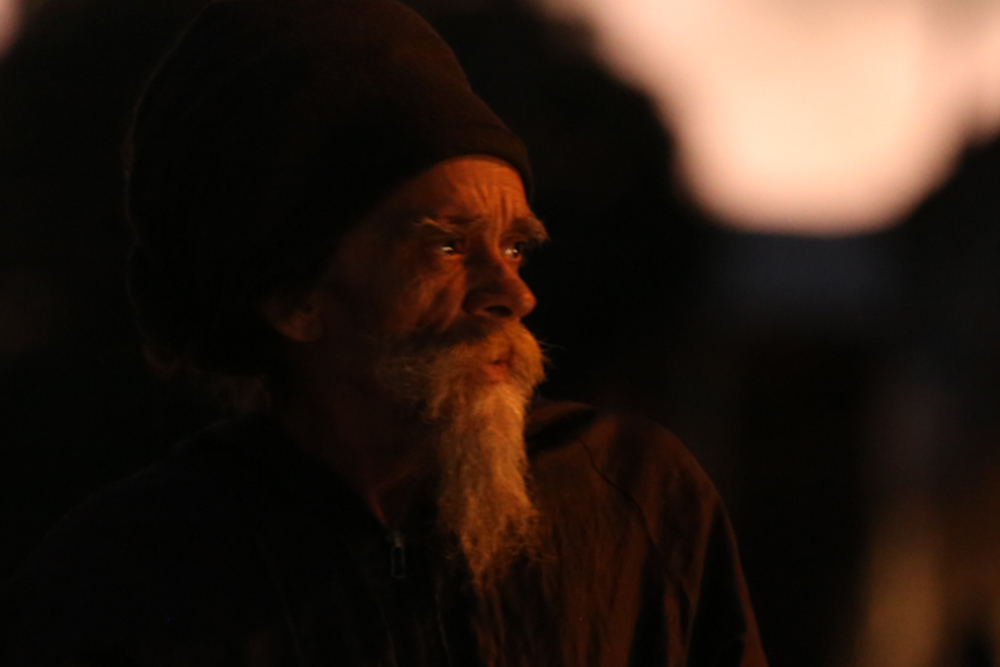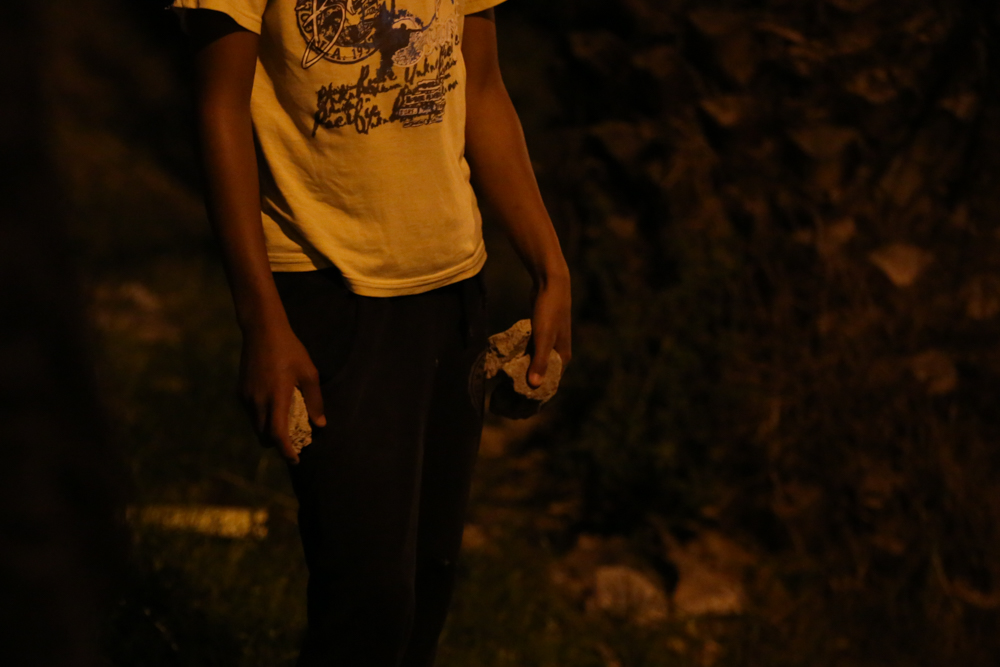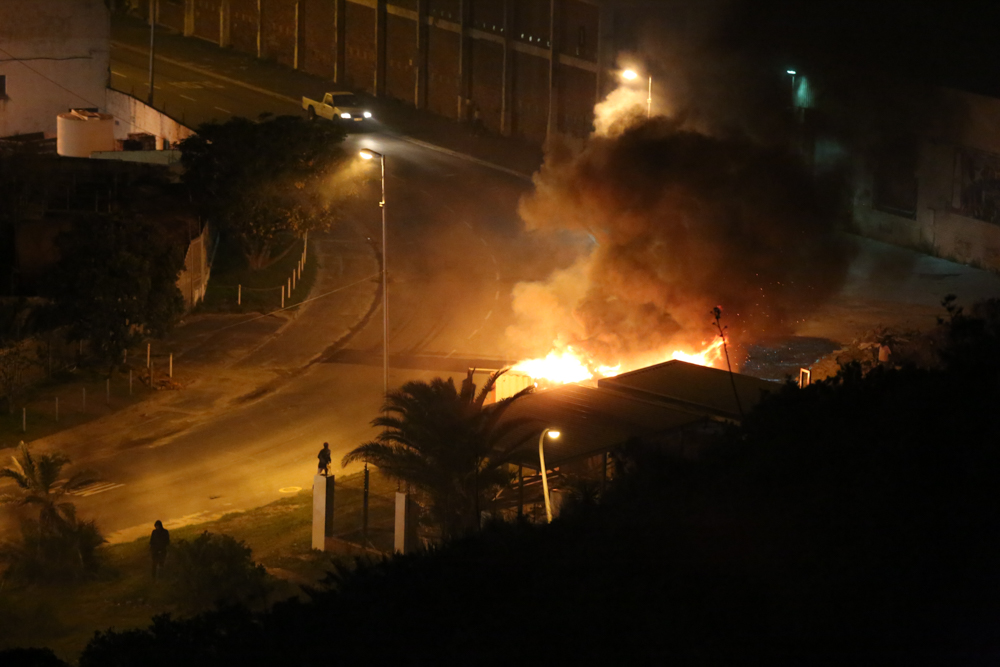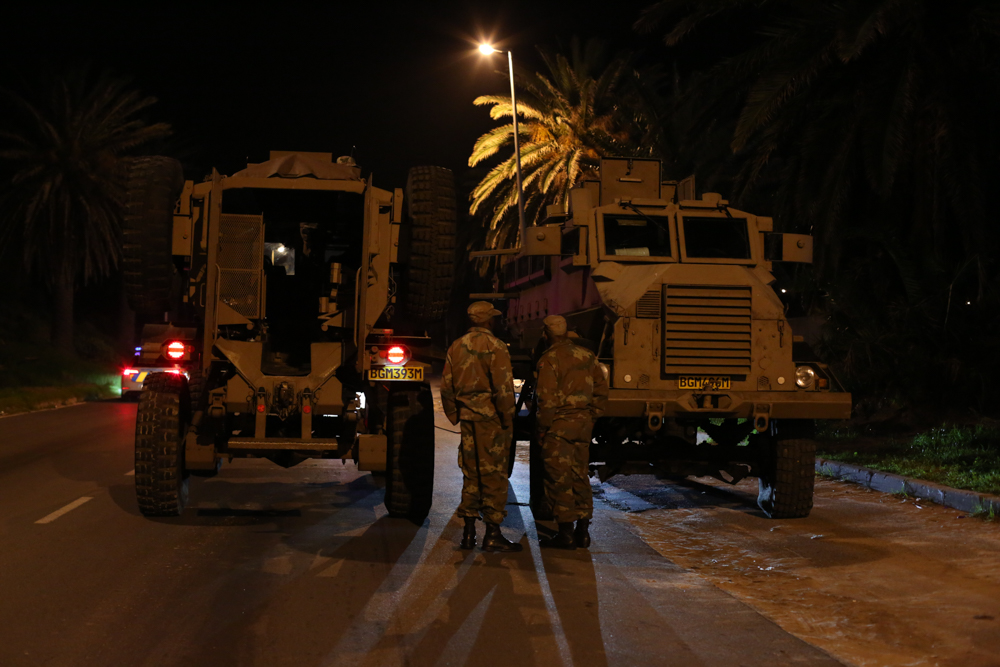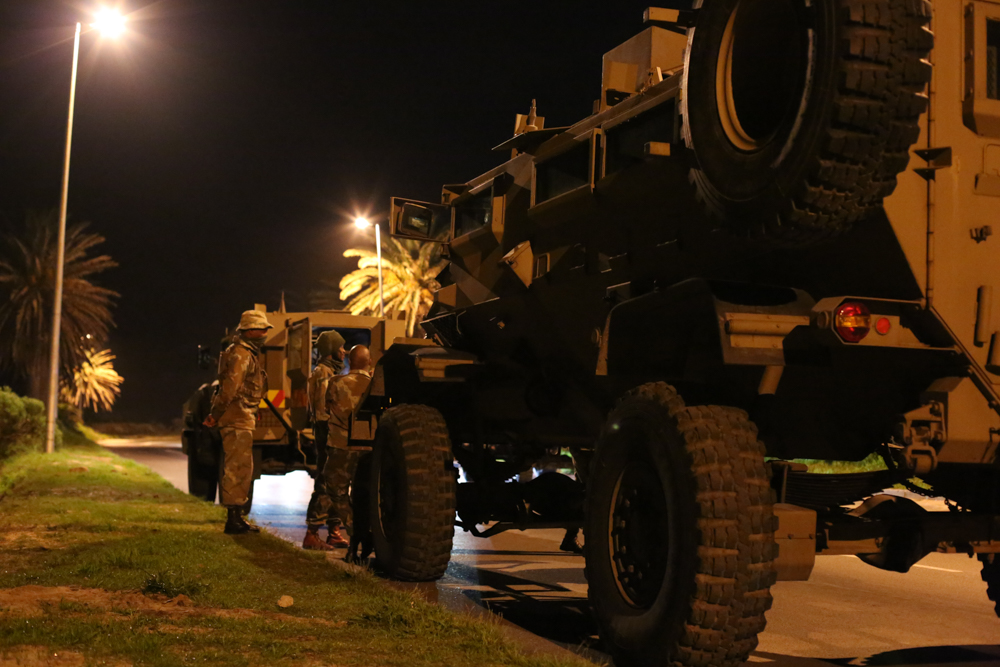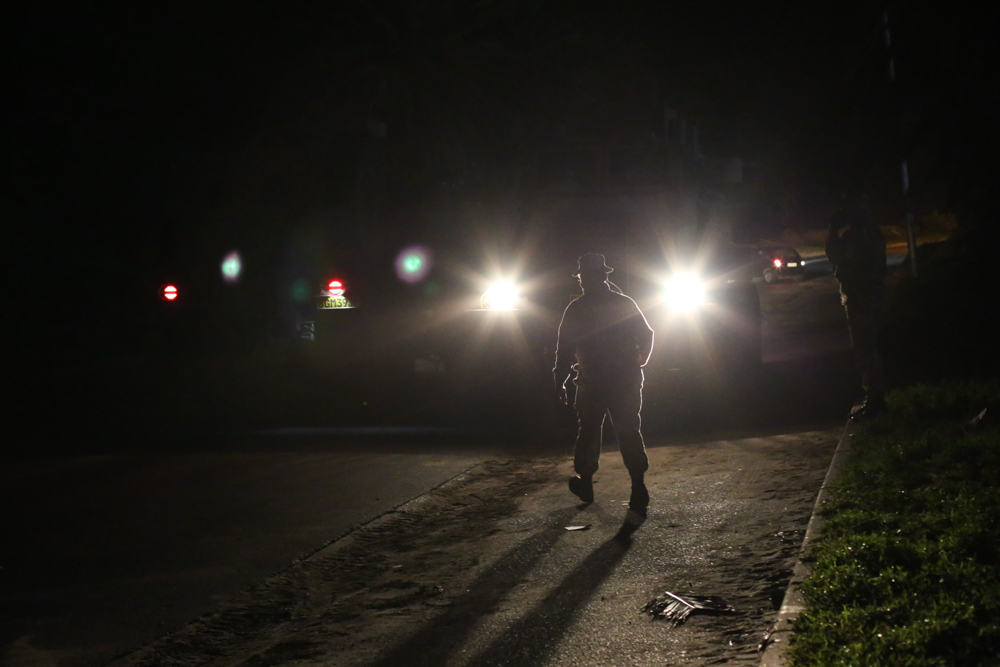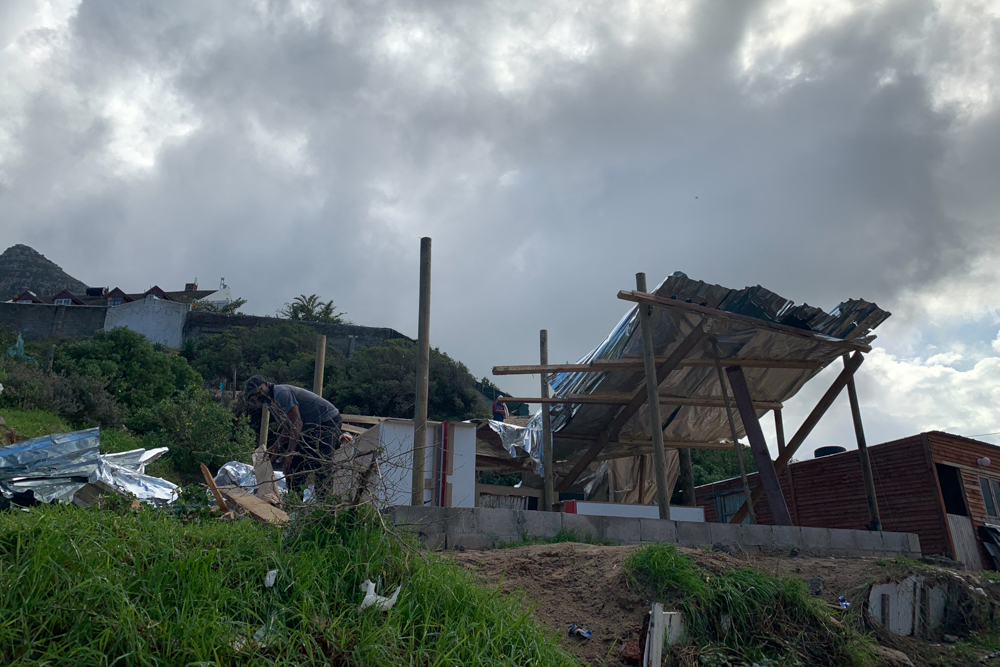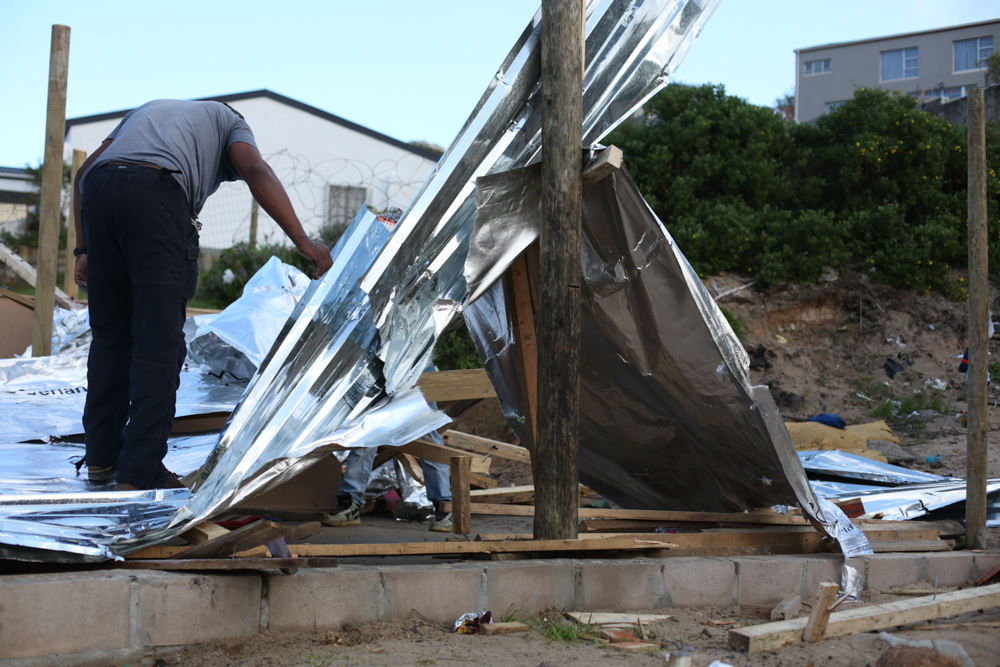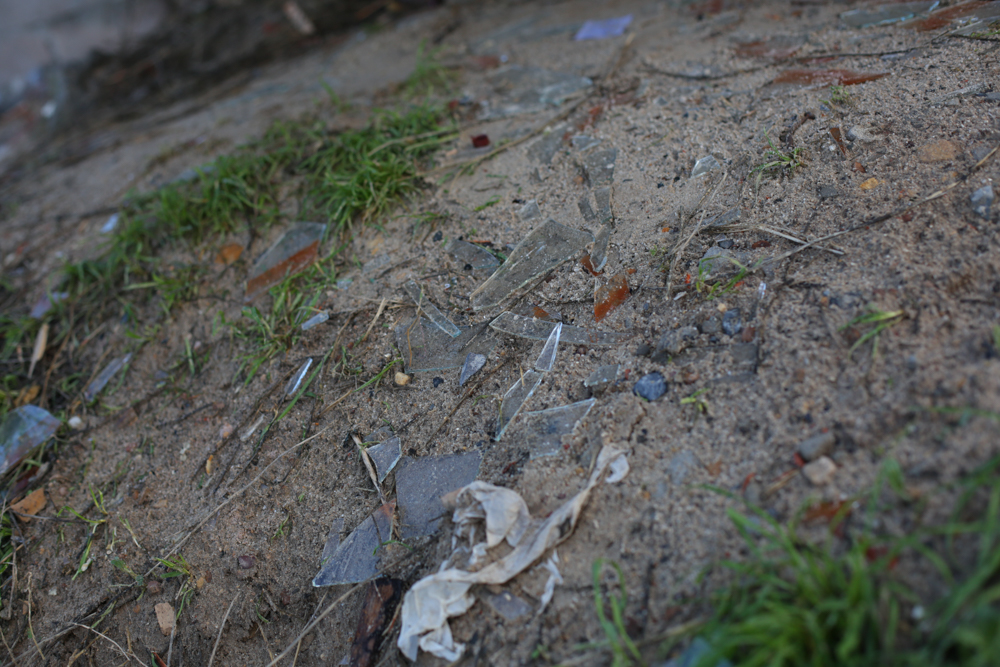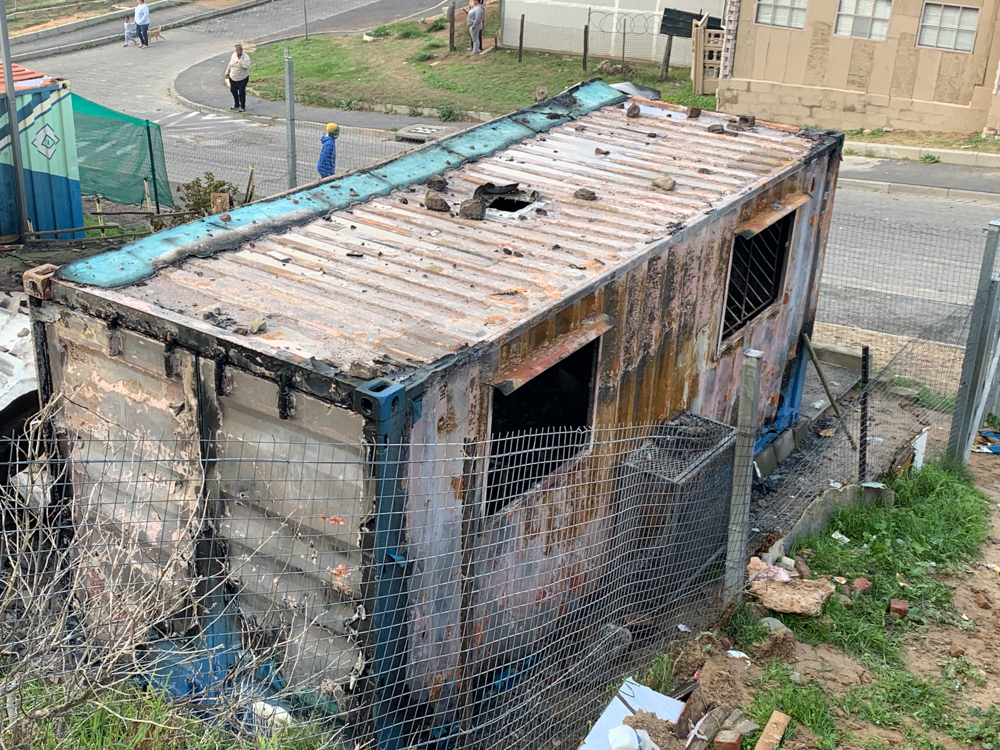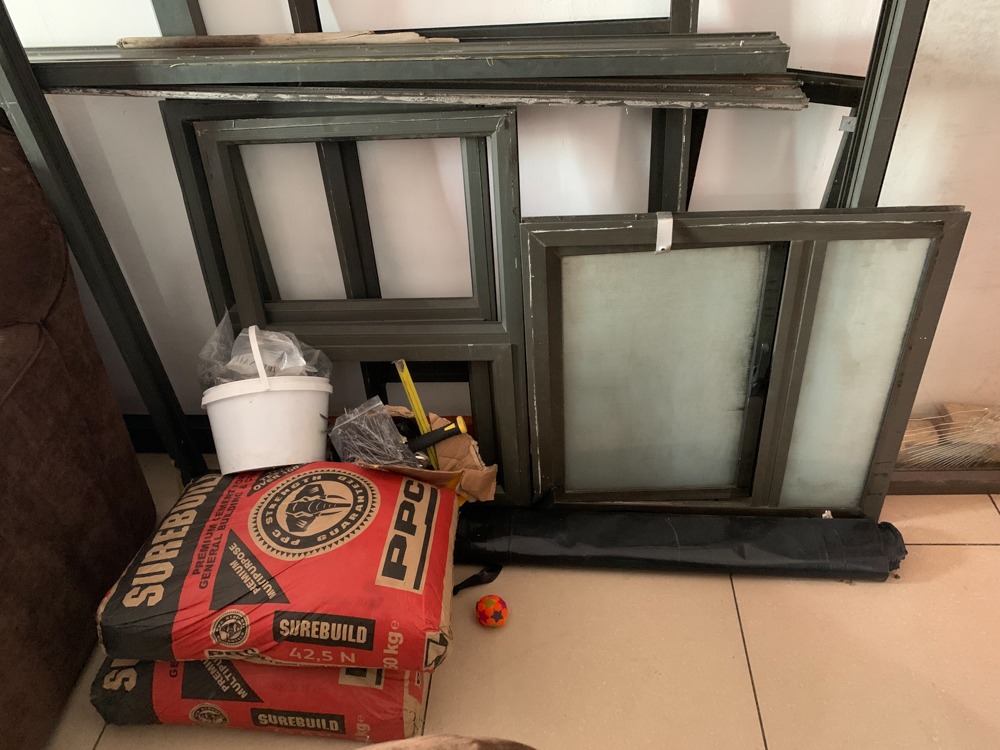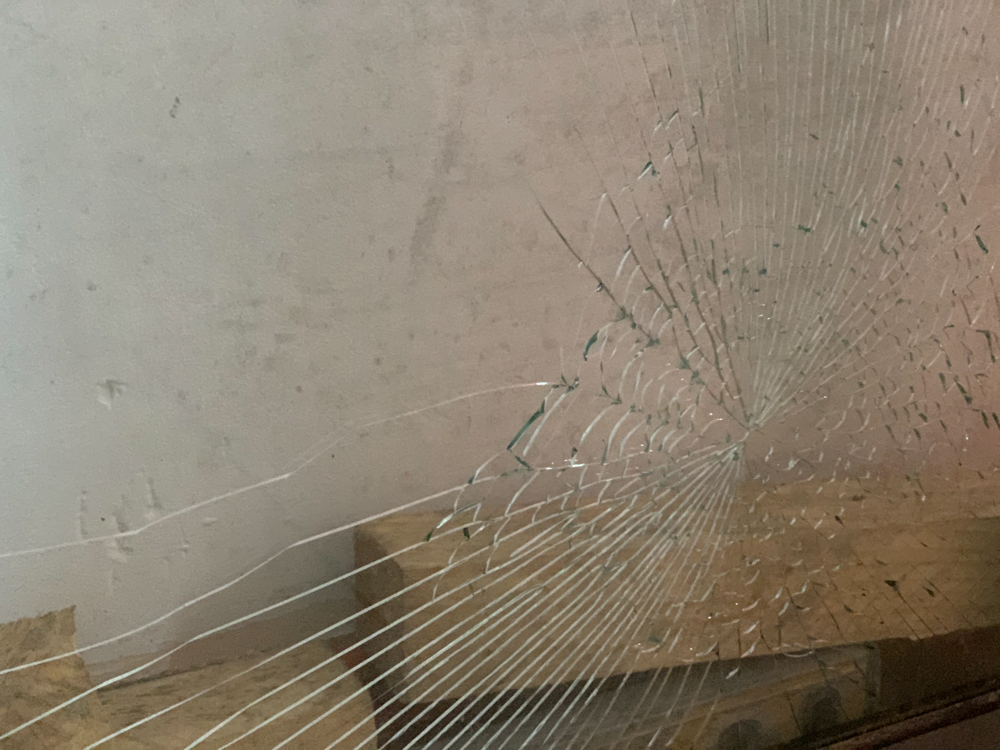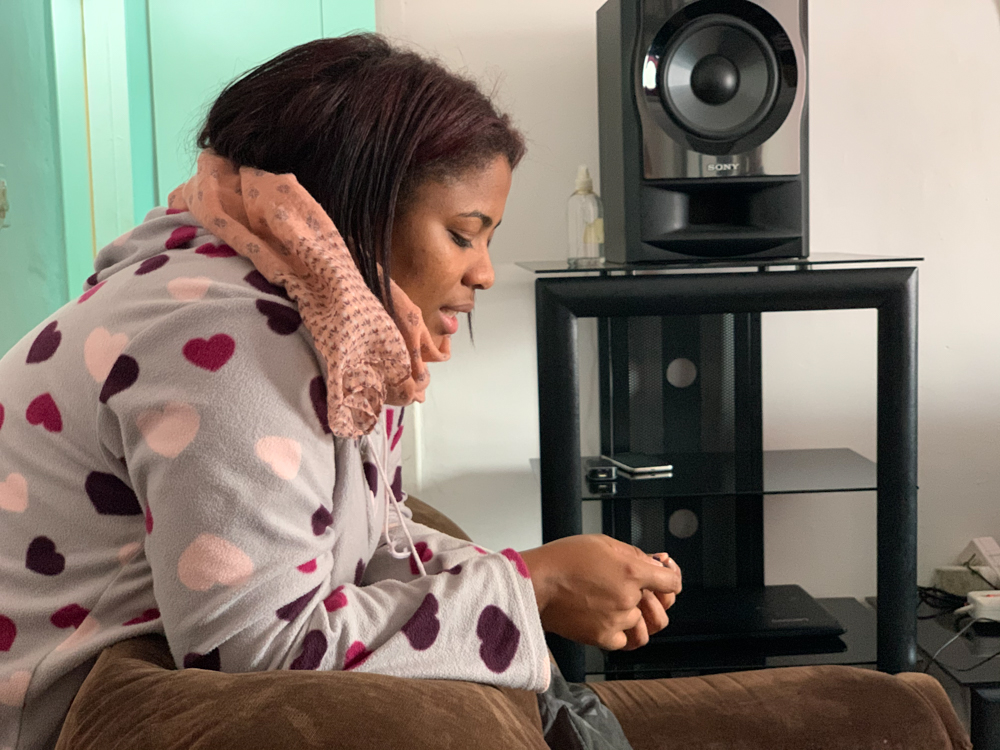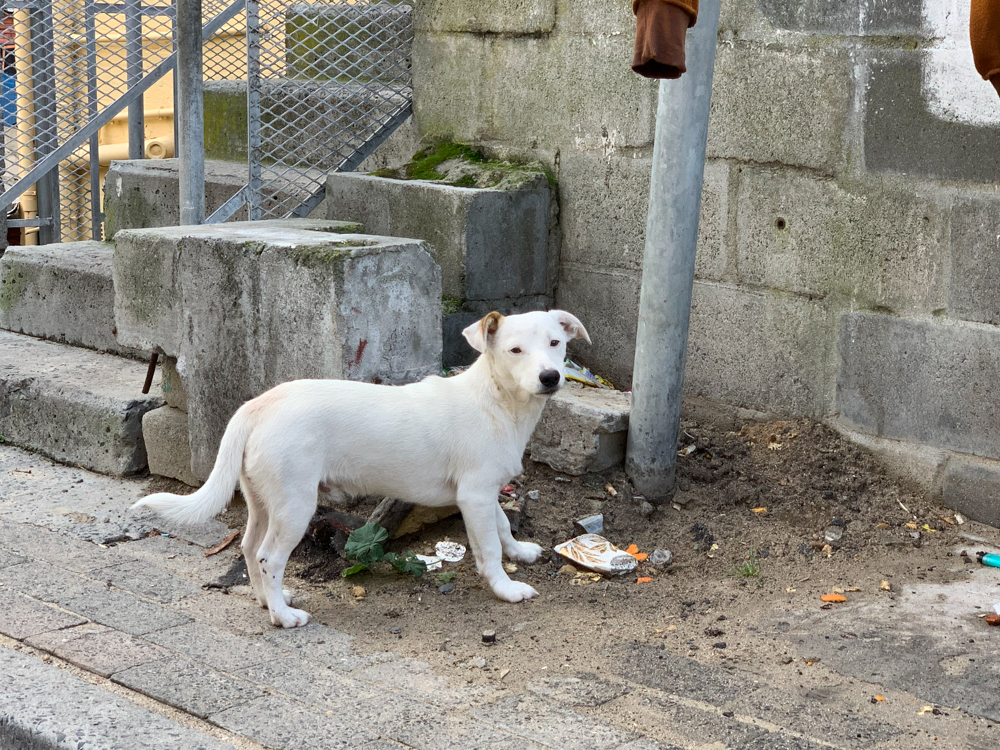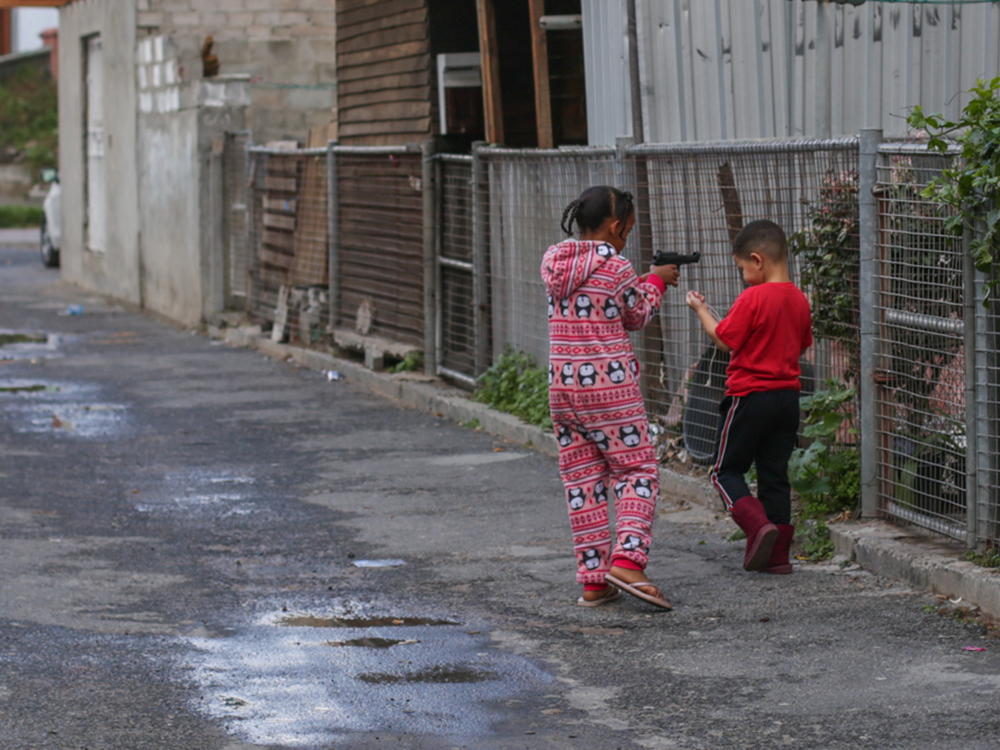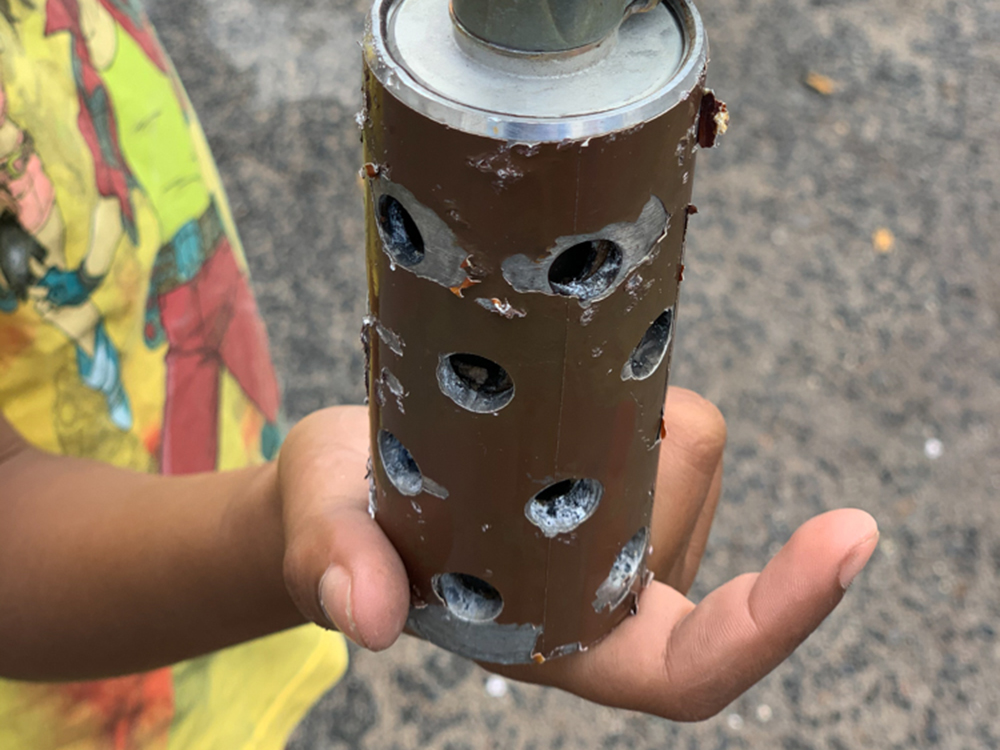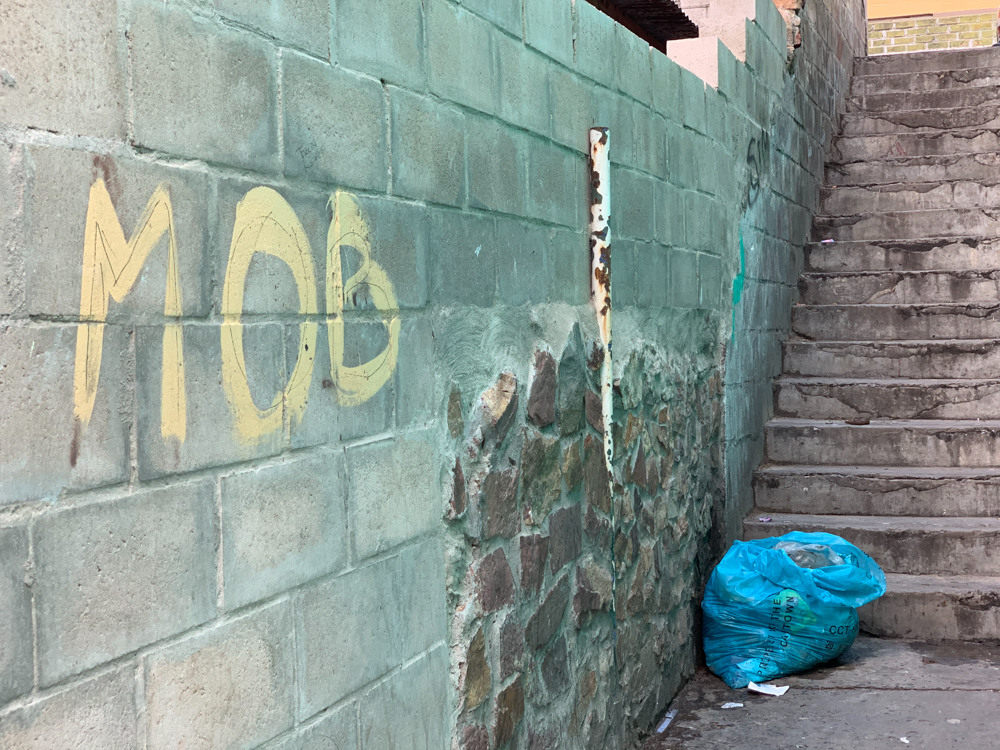Demolishing Hope – The battle for land and housing in Hangberg
June 2020
On Saturday morning, the air is crisp as I stand at the site of a demolished structure in Hangberg, Hout Bay. A man is dismantling sheets of corrugated iron loosely attached to broken poles, while another is pulling nails out of damaged planks of wood. Torn sheets of plastic are blowing in the wind and a group of children are playing in the sand beside the demolished structure.
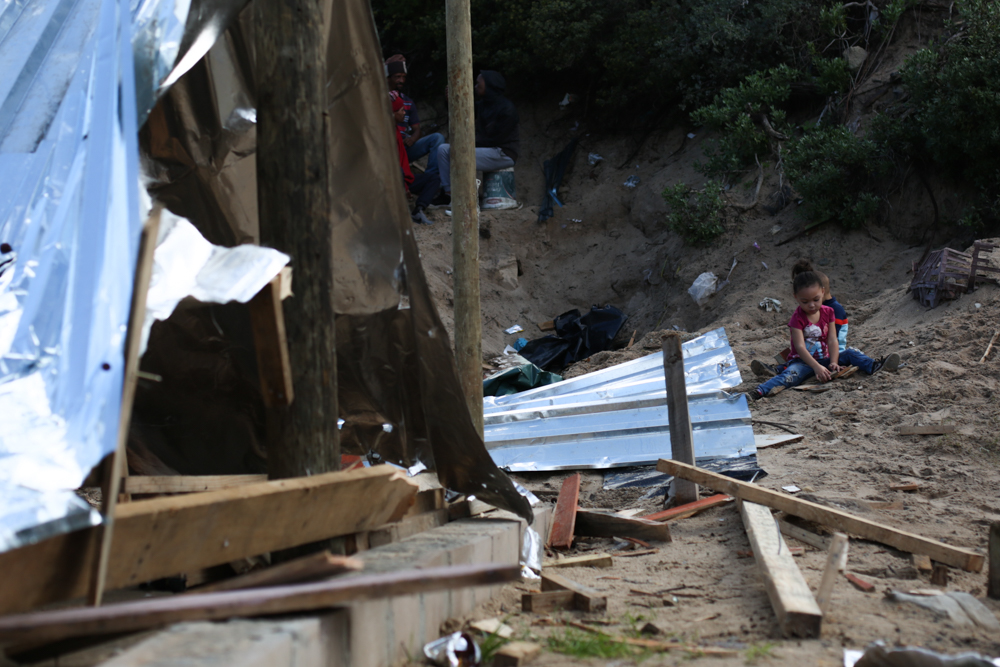
20 June 2020. Children play in the sand next to the structure that was demolished the night before.
The night before I had been standing in almost the exact same spot, but the scene was not the same. Instead of the bright sunshine that now broke through the clouds, the air had been heavy with a shower of rubber bullets and rocks, the cries of angry people piercing through the chaos. I had ducked behind a small tree, hoping its thin trunk would protect me from the flare shooting past my head before erupting in a burst of red that lit the darkened sky.
It was hard to keep track of everything that was happening. Only moments before I had seen about 40 Law Enforcement vehicles from the City of Cape Town pull into the harbour, officers streaming out of their armoured vehicles with bulletproof vests and shields to demolish a single illegal structure in the community. The night erupted into violence between the people and the police and before midnight struck, the roads had been barricaded by burning bins, teargas filled the air, rounds of gunfire had been shot, two buildings set on fire, and at least six military Casspirs had been deployed to force calm in the community.
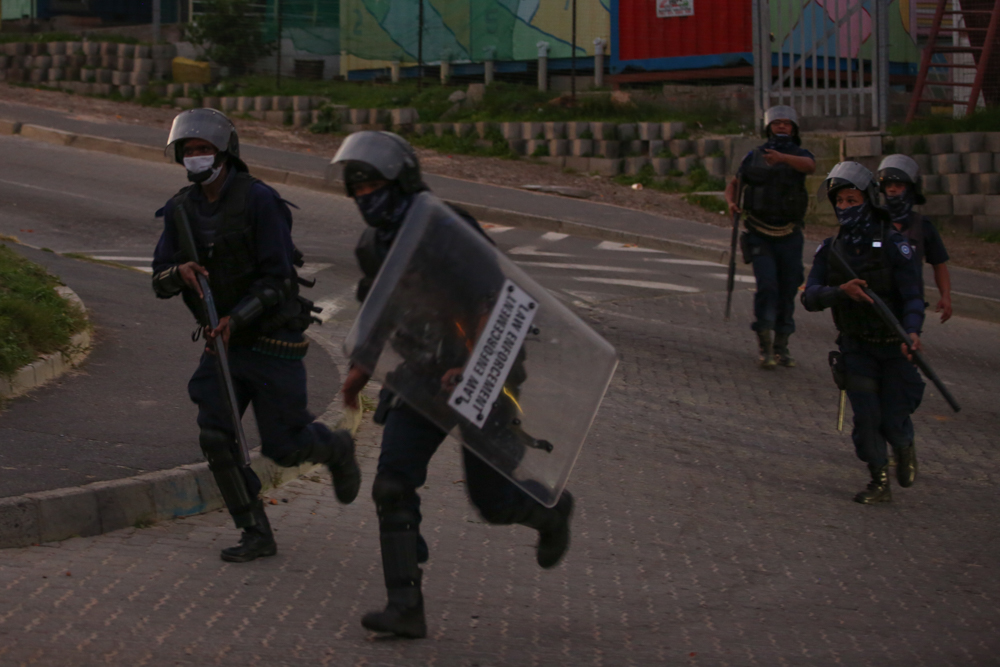
19 June 2020. Law enforcement officers run through the streets as violence escalates after a single ‘illegal’ structure is demolished.
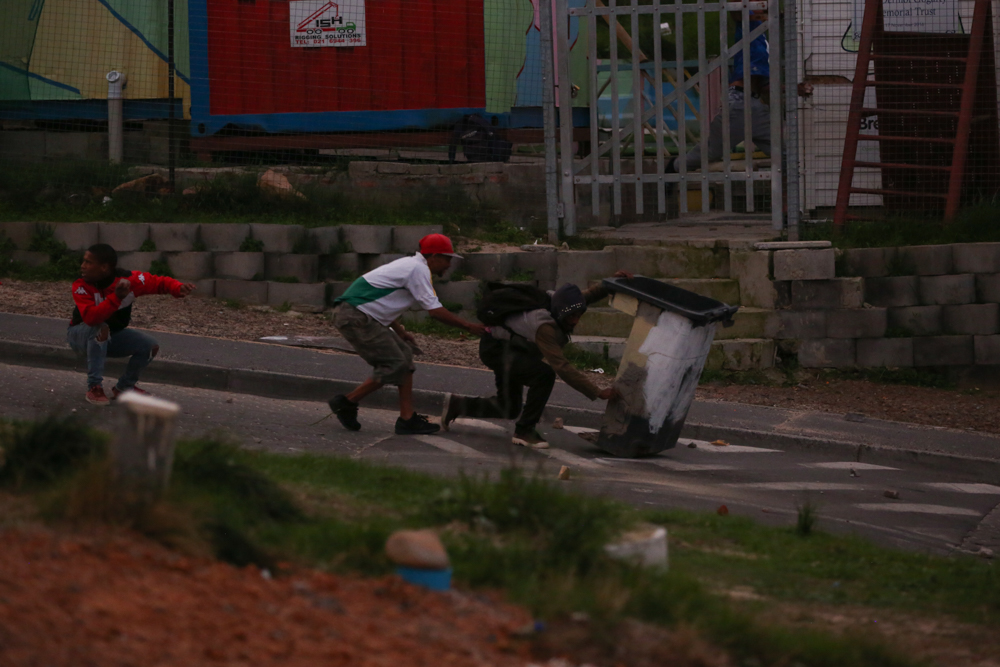
19 June 2020. Residents hide behind a small barricade after violence breaks out.
‘I was so scared that my stomach was turning. I felt so helpless,’ comments Shadé Daizy, a resident of Hangberg.
Shadé explains it was her brother’s house that had been demolished. The structure, considered illegal by the City of Cape Town because he didn’t have approval to build on the land, had only been up for a week. It was the second time the structure had been demolished – only the week before it had been knocked down following a demolition order from the City issued on the coldest and wettest day of the year, and a violent incident had ensued where police tear-gassed the local school and fired rounds of rubber bullets.
‘My brother had been living there for a week. When the police arrived they said they were just checking to see if the structure was occupied, which it was. There was even a child inside playing video games. We thought everything was fine because they didn’t have any documents and they said they wouldn’t do anything. But then they came back 10 minutes later and started tearing everything down.’
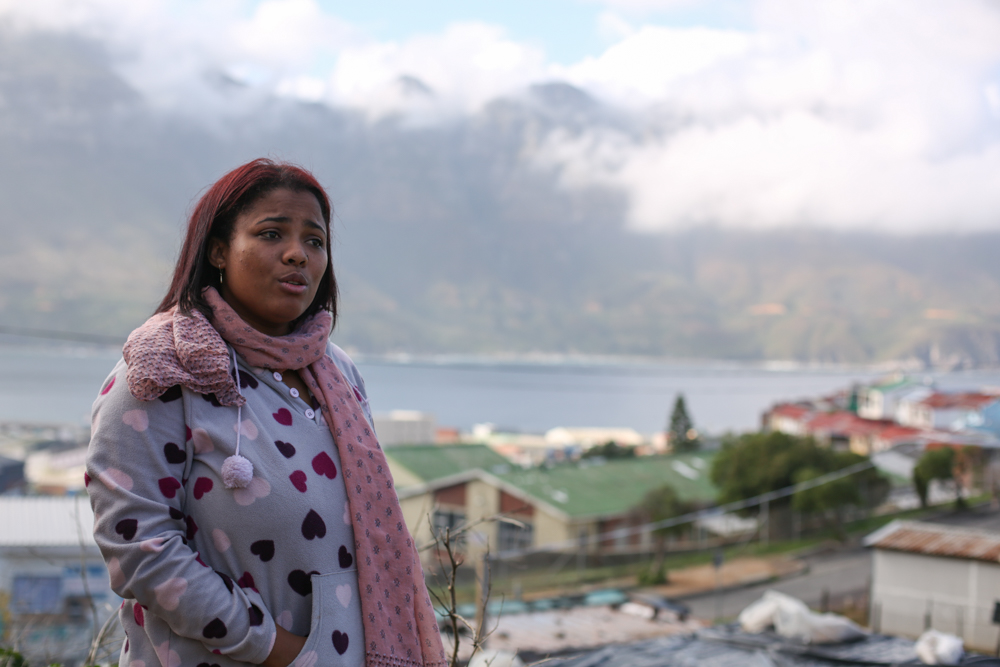
20 June 2020. Shadé Daizy shares her story on site, saying how she was ‘sick to her stomach’ when the police moved in to destroy her brothers house.
The problem of housing has been a long-standing issue in Hangberg. The forced removals during apartheid spatial planning caused a scaring emotional wound for the community who have a deep connection to both the land and the sea, and access to decent housing has been problematic ever since. While the population has grown considerably, housing has remained largely the same since the mid-1990s and the area is known for its poor service delivery. This came to a head in 2010 during the Battle of Hangberg when, after a series of forced evictions on the slope of Sentinel Mountain, a war erupted between the residents and the City. In response, the Hangberg Peace Accord was signed and the courts mandated that housing be developed on specific plots of land. But the Peace Accord swiftly fell apart and there has been almost no formal housing development, apart from one block of flats, within the past 10 years. This failure has been the cause of several violent protests over the years.
‘We don’t want to fight, but what else can we do?’ asks Shadé.
‘When I saw the military come in, I was furious. Why is it there are no police available when a rape happens, or a murder happens? We call the police station and are told there are no vehicles, no officers available. But then they send this amount of force for one structure? It just doesn’t make sense. It makes you angry. If they just invested this energy in the community instead of the police, we wouldn’t have these problems. The police are just legal gangsters.’
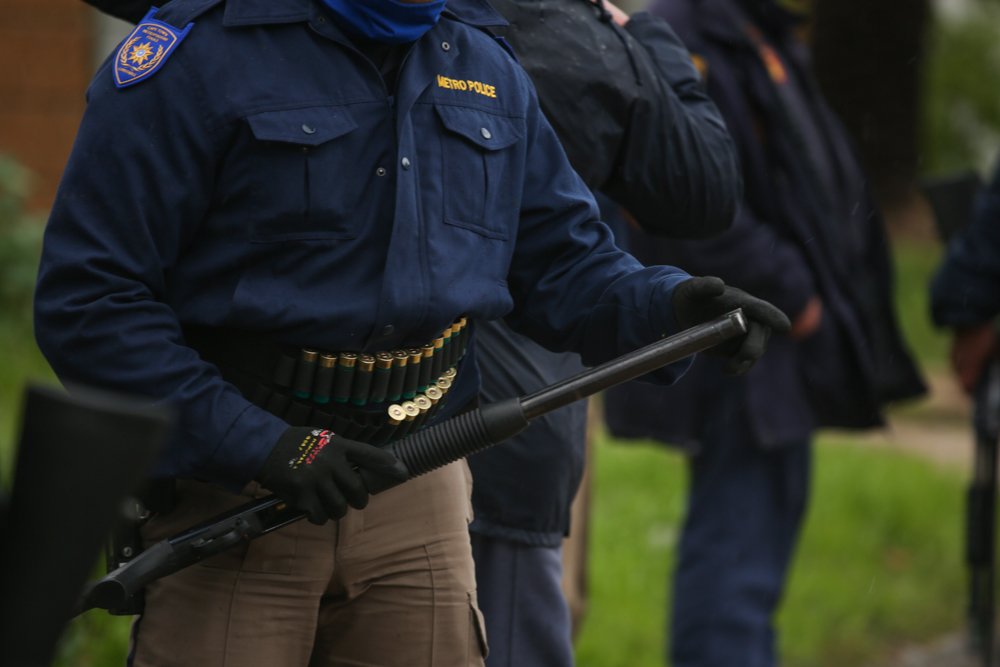
11 June 2020. Metro Police, under instruction from the City of Cape Town, are armed and ready to demolish structures in Hangberg.
Listening to her, it’s hard not to make the connection between the global movement of #BlackLivesMatter and the campaign to #DefundThePolice. This is exactly what the movement is advocating for – shifting resources away from a brutal and oppressive police force and instead redirecting funds towards social services and programmes that actually help to lift a community up.
‘What if they put these resources into the youth? What kind of a community would we have then?’
As if on cue, two boys walk up to me holding an empty teargas canister they found on the road and a young girl in the background pretends to shoot her friend with a toy gun. The impact the on-going violence has on the children cannot be overstated. The community is desperate for social services, but the only things to be found are the broken bottles and rocks that litter the streets.
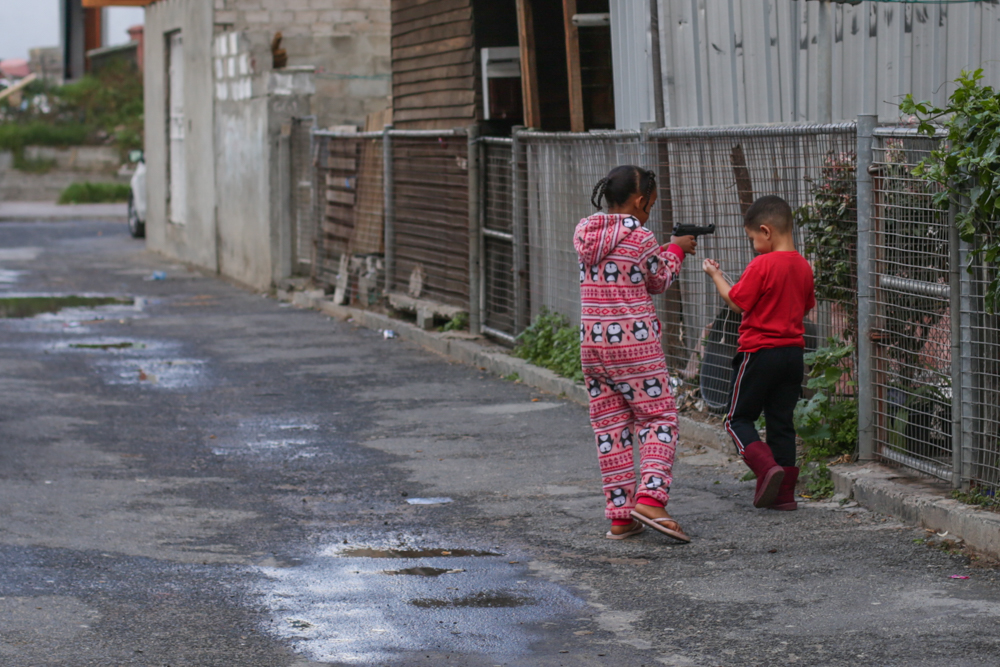
20 June 2020. A young girl pretends to shoot her friend with a toy gun. The on-going violence has a severe impact on children, yet there are still insufficient social services in Hangberg.
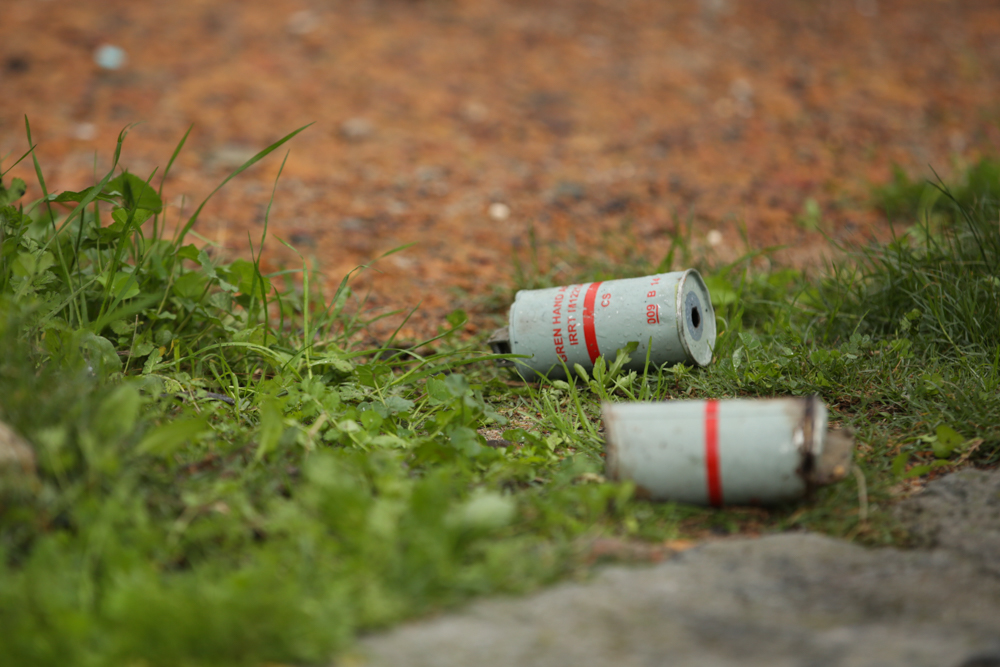
11 June 2020. Teargas canisters litter the streets after the violence subsides.
It is also true that in the chaos of the night before, a local crèche was burned to the ground, one of the few social institutions in the community. Many people ask why, in the wake of such need, would the community destroy the limited resources that they have? But the issues are complex, with some feeling there are different standards for different people, depending on what political party you are affiliated with.
‘Almost all the houses here are classified as illegal,’ explains one resident. ‘It’s just that some are more illegal than others. It all depends on whether you support the City. Some people can have their houses made legal if they report on other illegal structures. This is how the City divides and conquers within the community.’
While much of the anger is directed towards the DA, I can’t help but think that ‘divide and conquer’ is a common tactic for all political parties. The ANC causes division by constantly blaming their rampant corruption and greed on the ills of apartheid, casually shirking off responsibility for their poor governance and lack of service delivery over the past 26 years. The EFF causes division by returning to long-standing racial tensions, making statements such as ‘kill the Boers’ that incite racial violence. The DA seems to have chosen the path of class division, systematically implementing gentrification across the City and dismissing the needs of the poor, from the Bokaap, to Woodstock, to Observatory, and now Hout Bay.
Where is the leadership that unites, that brings people together to create a better society for all? All I can see are the broken shards of our post-apartheid dreams, scattered amongst the ashes of social inequality and injustice.
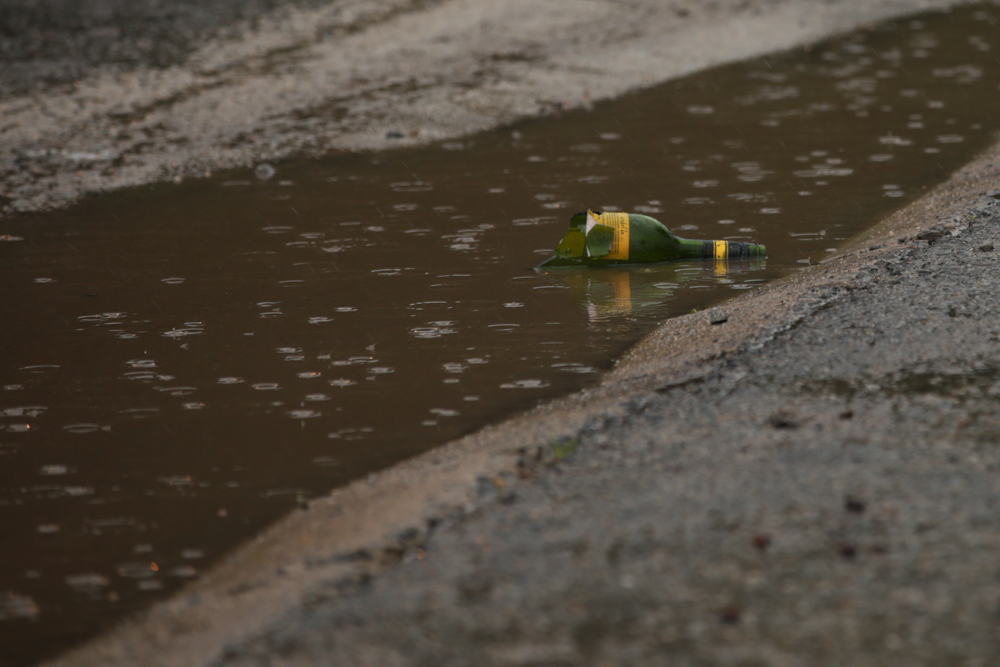
11 June 2020. A broken bottle lies in a puddle after being thrown at the police.
Admittedly, the City is in a difficult position. In the wake of the global pandemic of Covid-19, no evictions are allowed to take place, but the number of illegal houses has been increasing rapidly. While the City cannot demolish structures considered to be occupied, they also cannot let illegal structures to be erected on land allocated for different purposes. But of course, this problem would have been averted if they had just built the houses in the first place.
As we are standing on site, several community leaders arrive with Peace and Justice Witnesses and a representative from the South African Human Rights Commission (SAHRC).
Lee Smith, a community activist, explains that the City has broken the ‘gentleman’s agreement’ made at the end of 2019 where the community agreed that no protests would take place so long as no demolitions were done by the City. With no paperwork in hand and no justification for their brutish actions, he believes the City violated this agreement and the community’s response was warranted.
‘Crime is subjective,’ Smith explains. ‘Under apartheid, being coloured was a crime but that has changed. Now building a house for your family is considered a crime. But isn’t it more of a crime to destroy someone’s home?’
The SAHRC representative comments that his role is to remain neutral and objective, systematically identifying the facts. He does this carefully, allowing everyone to have their say and considering the weight of the situation. Much of the anger seems directed at the local Ward Councillor, but the SAHRC representative reminds them that he is not a representative of the City and instead it is the other way round – his role is to represent the community to the City. While this is indeed true, many do not seem satisfied that this is what happens in practice.
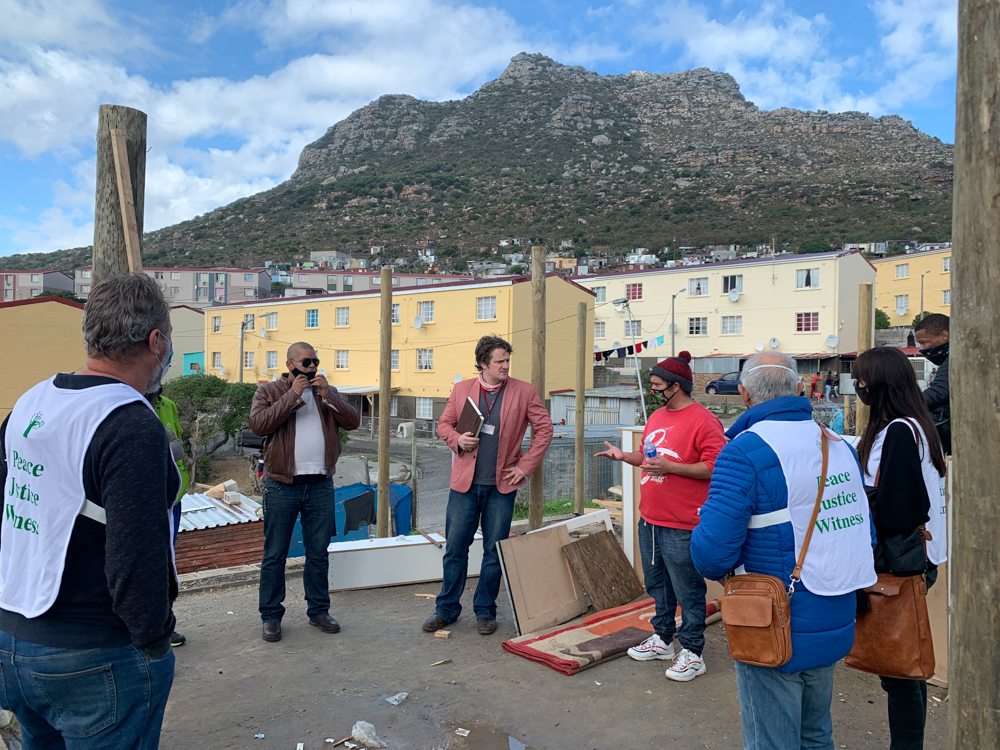
20 June 2020. Local community leaders meet with members of the South African Human Rights Commission and Peace and Justice Witnesses to try and find a way forward after the chaos.
While local leaders insist the City has broken their legal contract with the community through the Peace Accord, the SAHRC representative cautions that engaging in legal processes is difficult, especially for under-resourced communities like Hangberg. He comments that the City has the legal power to ‘out-muscle’ them every time and instead, he suggests, they need to find a way of meeting halfway.
‘Why must we meet halfway,’ asks Smith, ‘when it is us who suffer through this brutality, who have been waiting for houses and service delivery for decades? Why should we meet with them halfway when they are shooting teargas into our schools and firing rubber bullets into our streets?’
‘It’s called taking the higher ground,’ the SAHRC representative responds.
And therein lies the challenge – that those who have suffered the greatest injustice are also the ones expected to have the moral dignity and stamina to take the higher ground. I find myself thinking back to Mandela’s response at the end of apartheid, how despite all the cruelty and oppression and injustice, his focus was on reconciliation instead of retribution, on creating the new South Africa, rather than admonishing the perpetrators of the old. But this feels almost impossible now, particularly in the absence of any form of conscious leadership within the country.
After we leave the site, Shadé takes me to her mother’s house, a small two-bedroom apartment in a block of flats nearby. She comments that it’s easy to look at the chaos from the night before and to write it off as the community being difficult, but it’s important to understand the reasons behind this, to understand the conditions of how people are living.
Shadé explains that her mother has been in this apartment for 28 years, working hard to make a home for her family. Today there are eight people living here and every corner is filled – two couches sit in front of a small TV screen connected to a rickety sound system, and a small rectangular table is pressed into the corner. There are window frames and door frames leaning against the wall, with two bags of cement that you have to step over to get through. The room next door is the bedroom, consisting of a double bed and a bunk bed with three mattresses stacked on top, with barely enough space to walk between the two. There is a pile of folded blankets and a washing basket of laundry sitting on the bed.
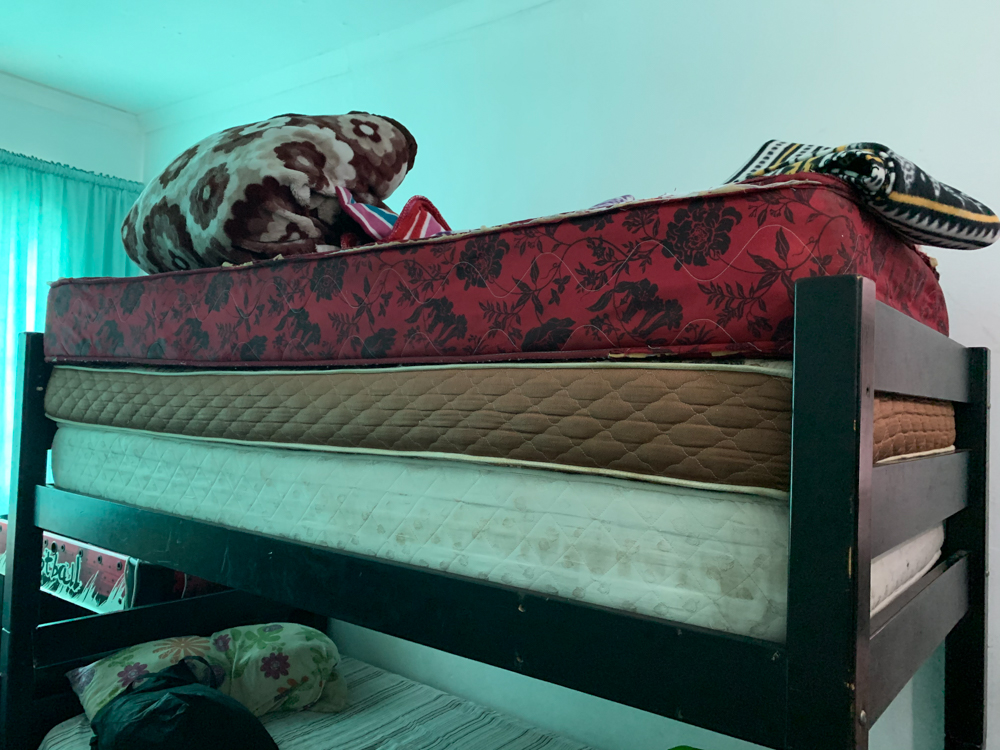
20 June 2020. Inside Shadé’s mother’s house, matresses are stacked on top of each other. Every night the house is rearranged so that the eight people living there can have space to sleep.
Shadé explains that every night the house is rearranged: the extra mattresses are taken off the bunk bed and put onto the living room floor, followed by a discussion about who gets the bed, the mattress, or the couch for the night. In the morning, everything must be re-arranged again, the mattresses and blankets stacked back on top of each other in the other room, an attempt to maintain some sense of normalcy for the family.
‘We are packed in here like sardines,’ comments Shadé. ‘We all just want our little place in the sun.’
While the home is modest and its difficult to imagine how eight people share such a small space, it’s also hard not to think that they have it better than many – here there is electricity, running water, a solid structure, and a stack of blankets to keep out the bitter winter cold. Just 500m up the road the landscape is different, with informal structures made from wood and corrugated iron balanced precariously on the mountain slope, sheets of plastic draped over the structures to keep out the fierce winter rains.
Outside, the streets are alive with activity. A shopkeeper passes sweets to eager hands through a small opening, a lady hangs laundry on a washing line in front of a parked car with a cracked window, and a man stands reading the newspaper as a small dog eats scraps of food from a heap of rubbish.
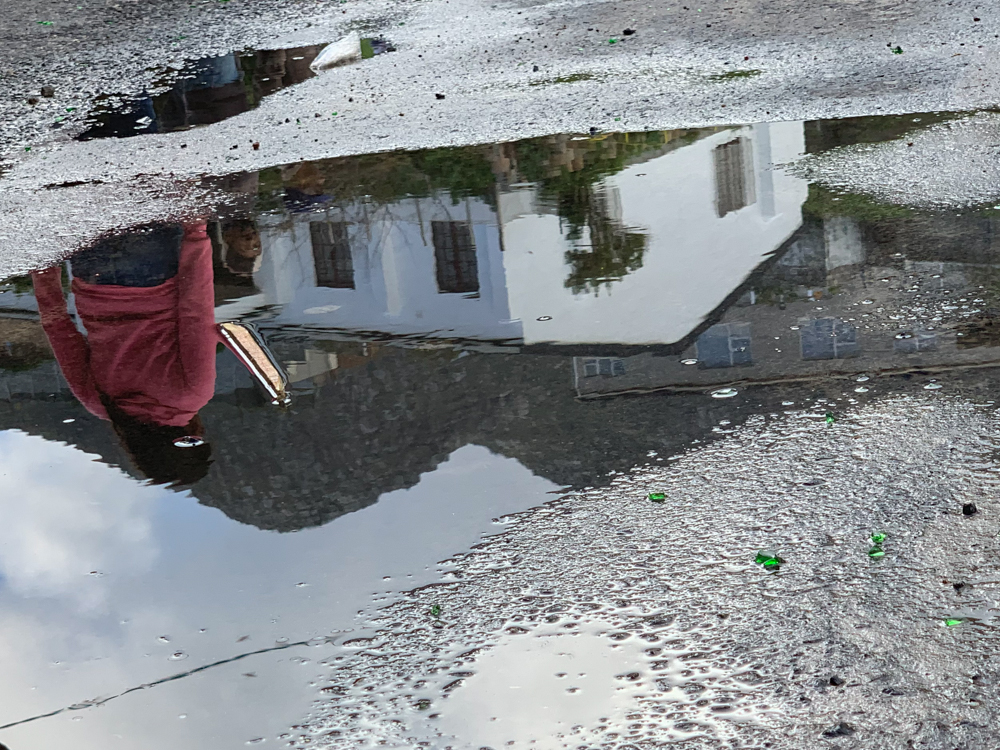
20 June 2020. Housing issues in Hangberg have persisted for more than a decade, yet still no housing has been provided. It often feels like the City’s response to service delivery is completely upside down.
As I begin to leave, more and more people start coming to share their story. There are so many unheard voices here and it seems everyone wants to speak.
‘We are tired,’ says one woman. ‘We are tired of being silenced. We are tired of this constant sense of desolation. Where am I supposed to go? What am I supposed to do?’
‘I’ve been waiting for a house for 25 years and I am still living hand to mouth,’ comments another man. ‘I was part of the underground movement during apartheid and lately I’ve been thinking we need to start that again. It feels like there’s no other way to go. People say life is like a bed of roses, but they forget that roses have thorns. There are a thousand thorns here and we experience them every day.’
Another woman explains that the issue of housing impacts every aspect of life, and fuels other issues like gender-based violence.
‘When your house is destroyed over and over again you feel powerless. People have to express their power somehow and so they pick on the weakest because it’s the only thing they have. This is the systemic violence that people don’t speak about. Our community is traumatised.’
It is believed there are a further 28 structures set to be demolished. If this is the show of force for just one structure, I shudder to think what the future will bring. Of all the choices the elected representatives of the people have before them in the execution of their duties, it’s hard to believe they have chosen this – to demolish hope and deepen despair.
As I walk away, one woman’s comment stays with me the longest.
‘My mother has been sleeping on the floor for 30 years. All she wants is a little bit of respect.’
Article published in the Mail & Guardian on 3 July 2020.
